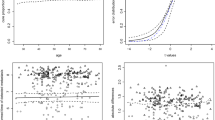Abstract
We propose a new cure model for survival data with a surviving or cure fraction. The new model is a mixture cure model where the covariate effects on the proportion of cure and the distribution of the failure time of uncured patients are separately modeled. Unlike the existing mixture cure models, the new model allows covariate effects on the failure time distribution of uncured patients to be negligible at time zero and to increase as time goes by. Such a model is particularly useful in some cancer treatments when the treat effect increases gradually from zero, and the existing models usually cannot handle this situation properly. We develop a rank based semiparametric estimation method to obtain the maximum likelihood estimates of the parameters in the model. We compare it with existing models and methods via a simulation study, and apply the model to a breast cancer data set. The numerical studies show that the new model provides a useful addition to the cure model literature.
Similar content being viewed by others
References
Berkson J, Gage RP (1952) Survival curve for cancer patients following treatment. J Am Stat Assoc 47: 501–515
Breslow N (1974) Covariance analysis of censored survival data. Biometrics 30: 89–99
Chen YQ (2001) Accelerated hazards regression model and its adequacy for censored survival data. Biometrics 57: 853–860
Chen YQ, Wang MC (2000) Analysis of accelerated hazards models. J Am Stat Assoc 95: 608–618
Fang HB, Li G, Sun J (2005) Maximum likelihood estimation in a semiparametric logistic/proportional-hazards mixture model. Scand J Stat Theory Appl 32: 59–75
Farewell VT (1982) The use of mixture models for the analysis of survival data with long-term survivors. Biometrics 38(4): 1041–1046
Jin Z, Lin DY, Wei LJ, Ying Z (2003) Rank-based inference for the accelerated failure time model. Biometrika 90: 341–353
Kalbfleisch JD, Prentice RL (2002) The statistical analysis of failure time data. John Wiley & Sons, Hoboken
Kuk AYC, Chen CH (1992) A mixture model combining logistic regression with proportional hazards regression. Biometrika 79(3): 531–541
Li CS, Taylor JMG (2002) A semi-parametric accelerated failure time cure model. Stat Med 21: 3235–3247
Louis TA (1982) Finding the observed information matrix when using the EM algorithm. J R Stat Soc Ser B 44: 226–233
Meilijson I (1989) A fast improvement to the EM algorithm on its own terms. J R Stat Soc Ser B 51: 127–138
Peng Y, Dear KBG (2000) A nonparametric mixture model for cure rate estimation. Biometrics 56(1): 237–243
Peng Y, Dear KBG, Denham JW (1998) A generalized F mixture model for cure rate estimation. Stat Med 17: 813–830
Ritov Y (1990) Estimation in a linear regression model with censored data. Ann Stat 18: 303–328
Surveillance and Epidemiology and End Results (SEER) Program (www.seer.cancer.gov), Limited-Use Data (1973–2005) National Cancer Institute, DCCPS, Surveillance Research Program, Cancer Statistics Branch, released April 2008, based on the November 2007 submission
Sy JP, Taylor JMG (2000) Estimation in a Cox proportional hazards cure model. Biometrics 56(1): 227–236
Yamaguchi K (1992) Accelerated failure-time regression models with a regression model of surviving fraction:an application to the analysis of “permanent employment” in Japan. J Am Stat Assoc 87: 284–292
Zhang J, Peng Y (2007) A new estimation method for the semiparametric accelerated failure time mixture cure model. Stat Med 26: 3157–3171
Author information
Authors and Affiliations
Corresponding author
Rights and permissions
About this article
Cite this article
Zhang, J., Peng, Y. Accelerated hazards mixture cure model. Lifetime Data Anal 15, 455–467 (2009). https://doi.org/10.1007/s10985-009-9126-4
Received:
Accepted:
Published:
Issue Date:
DOI: https://doi.org/10.1007/s10985-009-9126-4




